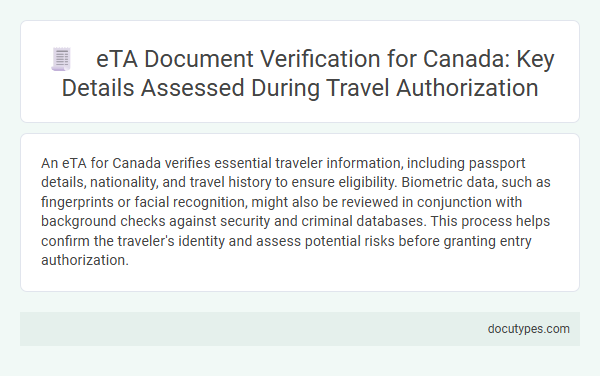An eTA for Canada verifies essential traveler information, including passport details, nationality, and travel history to ensure eligibility. Biometric data, such as fingerprints or facial recognition, might also be reviewed in conjunction with background checks against security and criminal databases. This process helps confirm the traveler's identity and assess potential risks before granting entry authorization.
Understanding Canada’s eTA: An Overview
Understanding Canada's eTA is essential before you travel to Canada. The eTA verifies specific personal and travel-related details to ensure eligibility for entry.
- Personal Identification - The eTA checks your passport details to confirm identity and nationality.
- Travel Plans - It reviews the intended dates and purpose of your visit to Canada.
- Background Screening - The system scans for any security or criminal records that may affect your admissibility.
Importance of Document Verification in eTA Approval
The eTA (Electronic Travel Authorization) for Canada involves meticulous verification of personal and travel documents to ensure applicant eligibility. Key details checked include passport information, travel dates, and security background to prevent unauthorized entry. Accurate document verification is crucial for timely eTA approval and smooth border crossing into Canada.
Personal Information Validation in eTA Assessment
| Details Checked on an eTA for Canada | Personal Information Validation in eTA Assessment |
|---|---|
| Full Name | Verified against passport data to ensure exact matches without discrepancies |
| Date of Birth | Confirmed to align with official travel documents for identity accuracy |
| Passport Number | Cross-checked for validity and consistency with citizenship and travel records |
| Nationality | Validated to determine eligibility and apply country-specific regulations |
| Travel History | Reviewed in relation to immigration status and visa requirements |
| Contact Information | Used to confirm identity and facilitate communication during application processing |
| Purpose of Visit | Checked to ensure compliance with eTA conditions and Canadian border regulations |
| Security and Background Data | Assessed through screening against criminal and security databases |
Passport Requirements for Canada eTA Applicants
What passport details are verified for a Canada eTA application? The eTA system checks the passport number, expiry date, and country of issuance to ensure validity. Only passports from visa-exempt countries are accepted for Canada eTA applicants.
Travel History and Security Background Checks
An eTA (Electronic Travel Authorization) for Canada involves a thorough review of your travel history and security background. This process helps ensure that all travelers meet the requirements to enter Canada safely.
- Travel History Verification - Authorities examine previous international trips to identify patterns or risks associated with your travel conduct.
- Criminal Record Screening - Security databases are checked to detect any criminal activities that could disqualify you from obtaining an eTA.
- Risk Assessment - A comprehensive analysis evaluates potential threats based on your personal and travel information against security criteria.
The goal of these checks is to enhance border security while facilitating legitimate travel to Canada.
Validity and Expiry Rules for eTA Documentation
An Electronic Travel Authorization (eTA) for Canada must be valid at the time of travel and remains linked electronically to the applicant's passport. The eTA validity period can last up to five years or until the passport expires, whichever occurs first.
The expiry of the eTA is automatically triggered when the associated passport is no longer valid. Travelers should ensure their passport is valid throughout their intended stay in Canada. If the passport expires before the eTA, a new eTA application is required with the updated travel document.
Supporting Documents for eTA Verification
When applying for an eTA (Electronic Travel Authorization) for Canada, specific supporting documents are scrutinized to verify your eligibility. These documents ensure compliance with immigration requirements and facilitate a smooth travel experience.
- Valid Passport - Your passport must be from a visa-exempt country and remain valid throughout your stay in Canada.
- Proof of Travel - Flight details or travel itinerary are checked to confirm your entry and exit plans from Canada.
- Identity Verification Documents - Supporting identification, such as a national ID or driver's license, may be required to authenticate your identity during the eTA verification process.
Common Reasons for eTA Application Rejection
The eTA (Electronic Travel Authorization) for Canada requires verification of personal details such as passport information, travel history, and purpose of visit. Immigration authorities also check for any prior criminal records or security concerns linked to the applicant.
Common reasons for eTA application rejection include incomplete or incorrect information, expired passports, and previous visa or immigration violations. Applicants with criminal records or those flagged for security risks often face denial of their eTA application.
Digital Verification Processes for eTA Approval
The Electronic Travel Authorization (eTA) for Canada undergoes a thorough digital verification process to confirm the traveler's identity and eligibility. Key details checked include passport information, citizenship status, and travel history.
The system cross-references data with immigration and security databases to detect any restrictions or risks. Biometric and background checks enhance the accuracy of the eTA approval, ensuring secure entry protocols.
Which Details Are Checked on an eTA (Electronic Travel Authorization) for Canada? Infographic

